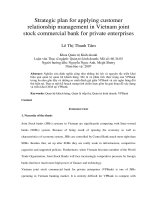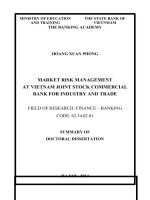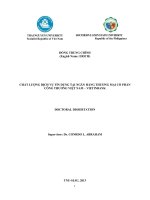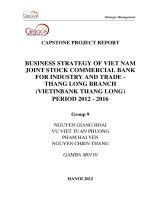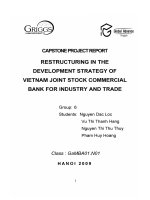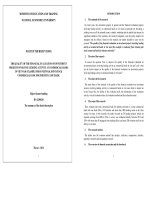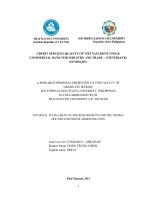summary of doctoral dissertatio market risk management at vietnam joint stock commercial bank for industry and trade
Bạn đang xem bản rút gọn của tài liệu. Xem và tải ngay bản đầy đủ của tài liệu tại đây (444.07 KB, 29 trang )
MINISTRY OF EDUCATION
AND TRAINING
THE STATE BANK OF VIETNMAM
THE BANKING ACADEMY
HOANG XUAN PHONG
HOANG XUAN PHONG
MARKET RISK MANAGEMENT
AT VIETNAM JOINT STOCK COMMERCIAL
BANK FOR INDUSTRY AND TRADE
FIELD OF RESEARCH: FINANCE – BANKING
CODE: 62.34.02.01
SUMMARY OF
DOCTORAL DISSERTATION
HA NOI - 2014
The dissertation is completed at: The Banking Academy
Instructors: 1. Assoc. Prof., PhD. To Ngoc Hung
2. PhD. Hoang Viet Trung
Opponent 1:
Opponent 2:
Opponent 3:
The doctoral dissertation has been defended to the
institutional level Jury at The Banking Academy
At: ………… of………April 2014
The thesis can be found at the library of The Banking
Academy and National Library of Vietnam.
3
INTRODUCTION
1. The necessity of the project
After the access into the World Trade Organization (WTO), the
integration degree of Vietnam into the global economy has become
increasingly deep and wide. The world integration can bring to the banks
in Vietnam with opportunities to learn, to acquire administration
experiences as well as make full use of advanced technologies, to
diversify products and services from countries with developed
economies. However, the integration also raises many difficulties and
challenges, of which the incalculable challenge for local banks is the
force of risks in the business together with increasingly complex market
factors, which have been liberated and appear more and more complex
natures. It is because that: the higher the diversification of banking and
financial products, the more the risk level is growing; the financial
environment has changed constantly and is hard to be controlled and this
is very likely to cause the domino reaction. Meanwhile, Vietnam's
commercial banks have still lacked practical experiences, been perplexed
in operating and controlling the activities of currency trading. Therefore,
in parallel with the comprehensive development goals, the good market
risk management to create a stable business environment is now a great
pressure over all commercial banks in Vietnam.
In that context, studying and managing the market risk to minimize
the losses for commercial banks is a very important issue with theoretical
and practical pressing significance both on the global level and in each
country. From the late 2002, to further enhance the tolerance of
commercial banks against bad situations in business operations, as well
as to ensure the safety of the system, the Commission on Banking
Supervision headquartered in Basel has issued regulations to standardize
the market risk management. Since then now, the tools and methods of
4
quantifying the values with market risks have been improved and
continuously invested.
In recent years, Vietnam Joint Stock Commercial Bank for Industry
and Trade has adopted a number of policies on minimizing the market
risks in order to be able to stand strongly in the competition and
determined to implement its strategies of building Vietnam Joint Stock
Commercial Bank for Industry and Trade into a powerful financial
conglomerate of Vietnam, the region and the world. However, under the
current volatile economic environment conditions, interest rates and
exchange rates , which have been changing constantly and
unpredictably at various times, have brought considerable damages to the
bank. Also, due to lacking experiences, comprehensive views, socio-
economic conditions, and the application of market risk management
standards in accordance with current international standards into
activities of the commercial banks in Vietnam in general and of Vietnam
Joint Stock Commercial Bank for Industry and Trade in particular is a
very difficult issue and should be further discussed and clarified.
From the theoretical and practical issues, I have choose the
project titled: “ Market risk management at Vietnam Joint Stock
Commercial Bank for Industry and Trade” in order to study and
defend my doctoral dissertation.
2. Research situation
So far, there have been many scientific research projects regarding
the risk management at commercial banks such as Hennie van Greuing
and Sonia Brajovic Bratanovic with the research named “ANALYZING
AND MANAGING BANKING RISK” 2003. In their research, authors
have mainly demonstrated the method of quantifying the market risks
with the Value At Risk (VAR) techniques. Methods of calculating VAR
include: Historical Method, The Variance-Covariance Method and
Monte Carlo Simulation. Currently, there has been no project on the in-
5
depth research of this issue in Vietnam, however, it should mention the
master thesis of Du Thi Minh “Managing exchange rate risk in forex
trading operations at Military Bank-Actual situations and solutions”,
2012, The Banking Academy; “Solutions to managing interest rate risk
at Vietnam Bank for Agriculture and Rural Development” – the
economic doctoral dissertation of the author Do Thi Kim Hao-2005.
In general, researches on market risk management at commercial
banks in a comprehensive manner is very limited. The sector-level
scientific research project on "Methods of managing market risk at
commercial banks in Vietnam", PhD. Pham Huy Hung coded KNH2008-
02, 2010 is one of the most comprehensive research projects to date on
the contents of market risk management in Vietnam. However, research
objectives of the project focus on several methods of quantifying market
risk and applying the above methods of quantifying for the commercial
bank system in Vietnam.
Most of research projects in Vietnam have not yet accessed to the
comprehensive market risk management at commercial banks in an
overall manner, including interest rate risk and foreign exchange risk, not
combined theoretical issues with practical operations in order to clarify
the basic objectives and contents of the market risk management,
generally researching methods for quantifying market risks; previous
researches have not raised complete solutions, overall recommendations
from models, procedure of market risk management, methods employed
for administrating, forecasting market movements especially associated
with the specific conditions of Vietnam Joint Stock Commercial Bank for
Industry and Trade.
The above “blank spaces” have suggested the author new research
directions in order to well implement the dissertation.
Therefore, it can be confirmed that the thesis titled “ Market risk
management at Vietnam Joint Stock Commercial Bank for Industry and
6
Trade” is the first doctoral dissertation which has systematically and
comprehensively studied contents of market risk management at banks as
theoretical basis for assessing the actual situation and proposing solutions
to improving capacities of market risk management at Vietnam Joint
Stock Commercial Bank for Industry and Trade.
3. Dissertation objectives
On the basis of clarifying the general theoretical issues about market
risk, methods of identifying, measuring and controlling market risk, the
system of market risk management softwares at commercial banks;
analyzing and evaluating the status quo of the market risk management in
Vietnam Joint Stock Commercial Bank for Industry and Trade; the thesis
proposed solutions to improving market risk management ability at
Vietnam Joint Stock Commercial Bank for Industry and Trade in
accordance with international practices.
4. Research subjects and scope
- Research subjects of the dissertation: The theoretical and practical
issues about market risks and market risk management at commercial banks.
- Research scope: Managing market risk (including interest rate risk
and exchange rate risk) at Vietnam Joint Stock Commercial Bank for
Industry and Trade from 2008 to 2012 and vision up to 2015
5. Research methodologies
Method of dialectical materialism and historical materialism, logical
method, statistical and synthesic methods, other methods such as:
comparative, inductive, deductive moethods.
6. Contributions of the thesis
The dissertation systematizes, clarifies theories on market risk
management in the context of world economic integration and
increasing competitive pressures in the business activities of
commercial banks; introducing basic contents about market risk
(within the scope: interest rate risk and exchange rate risk) of
7
commercial banks. Especially, the thesis has suggested ways of
building a standardized system about market risk management at
commercial banks from model, procedure and policy of market risk
management; stating experiences about market risk management at
some foreign commercial banks and drawn lessons for Vietnam.
Based on surveyed information, practical materials, the thesis has
introduced the overview about Vietinbank, analyzing the status quo of
the market risk management at Vietnam Joint Stock Commercial Bank
for Industry and Trade, pointing out basic successes and shortcomings,
weakness and causes of market risk management of the Bank - as the
basis for proposing innovation solutions, completing the market risk
management of Vietinbank in the coming time.
The dissertation has recommended 06 systems of solutions
appropriate to the conditions of Vietnam Joint Stock Commercial Bank
for Industry and Trade from building the risk management framework in
accordance with international standards; building, completing policy on
market risk management; completing model, procedure, methods and
tools of market risk management ; solutions to enhance modern technical
equipments, set up risk management softwares; strengthening the
predictabilities to training to the staff of officials in charge of market risk
management to better implement the market risk management of
Vietinbank market risk in the future.
7. The dissertation structure
In addition to the introduction and conclusions, the thesis is
structured into 03 chapters as follows:
Chapter 1: General issues about the market risk management of
commercial banks
Chapter 2: Market risk management in Vietnam Joint Stock
Commercial Bank for Industry and Trade
Chapter 3: Solutions to improving ability of the market risk management at
Vietnam Joint Stock Commercial Bank for Industry and Trade
8
Chapter 1
GENERAL ISSUES ON THE MARKET RISK MANAGEMENT
OF COMMERCIAL BANKS
1.1. Market risk in operations of commercial banks
1.1.1. The concept of market risk
The market risks may be defined as the possibility of loss to the bank
cause by the changes in market variables. It is the risk that the value of
on-/ of- balance sheet positions will be adversely effeced by the
movements in equity and interest rate markets, currency exchange rates
and commodity prices, or risks for earnings and capital of the bank due
to changes in the market level of interest rates, prices of securities,
foreign exchange and equities as well as the volatilities of those prices .
1.1.2. Types of the market risks
In general, the market risk includes interest rate risk, foreign
exchange risk, securities risk and commodity risk.
1.1.2.1. Interest rate risk
a. The concept of the interest rate risk
The interest rate risk at commercial banks is potential losses which
the bank shall bear when the market interest rate fluctuates. The
interest rate risk is the risk of fluctuations in income and net value of
the bank when the market interest rate changes.
b. Types of interest rate risks:
The interest rate risk consists of three types: Outright Risk, Yield
Curve Risk and Basic Risk.
c. Effects of the interest rate risk
It affects the earning perspective of the bank.
It also has effects over the market value of assets.
1.1.2.2. Exchange rate risk
a. The concept of the exchange rate risk
Foreign exchange risk is the current or future risk potential on income
and capital due to adverse fluctuations in currency exchange rates.
9
Foreign exchange risk in this thesis consists mainly of exchange rate risk
- which is the losses caused by the fluctuations of the exchange rate.
b. Risk types in currency exchange business
It includes operational risk; liquydity risk; settlement risk; market risk.
c. Effects of exchange rate risk
A bank with a large open foreign currency position is capable of
coping with significant losses when the exchange rate changes. The bank
is under the currency exchange risk when maintaining the open foreign
exchange position (open position).
1.1.3. Market risk quantification
According to the latest updated theories, the market risk
quantification can be applied in accordance with four methods and basic
criteria: (1) consequences of risks and (2) the probability of risks.
Consequences and probability of risks are of two levels from the low to
the high. With the two above criteria, the market risk quantification can
be described in the following table:
Table 1.1: Methods of market risk quantification
Measurement methods
Measurement Consequences
Probabilit
y
1. Interest rate gap Interest rate risk No No
2. The interest rate sensitivity
(PVBP/Duration)
Interest rate risk Yes No
3. Currency revaluation (mark -
to- market)
Exchange rate
risk
Yes No
4. Value at risk (VaR) Interest rate risk
and Exchange
rate risk
Yes Yes
1.2. The market risk management at commercial banks
1.2.1. Concepts
The market risk management at commercial banks are the measures,
operations affecting market risk, including measuring, identifying,
CEO
Trading Operaons
Front oce Middle oce Back oce
10
monitoring, controlling market risks of banks in order to minimize
possible negative effects on the bank's earnings in the event of the market
changes. In the aspect of operations, the market risk management is the
application of financial instruments to limit or minimize financial loss
caused by market risks.
1.2.2. Objectices of the market risk management
1.2.2.1. Minimizing losses for the bank
One of the important objectives in the market risk management is to
limit, to the maximum extent, any adverse effect of fluctuations in
interest rates and exchange rates over the bank's income. Although
interest rates, exchange rates change, banks always want to achieve their
expected incomes at a relatively stable level.
1.2.2.2. Increasing profits for the bank
In addition to minimizing losses caused by market risks, the bank can
maximize its profits with the correct predictions about the volatility of
interest rates, exchange rates in future.
1.2.3. Contents of the market risk management
1.2.3.1. The risk management model
The standard risk management model can be referred
and applied as follows:
Figure 1.1: Risk management model
Risk management
11
Source: Consultation documents of ING
The bank needs to build a model of risk management in accordance
with business scale and features. However, in the modern business model
there is still a clear bound of duty among three departments: business, risk
management and operation in order to support and monitor each other.
1.2.3.2. Market risk management policy
Market risk management policy is a system of limitations and
documents on risk activities for the entire bank. Effective risk
management rule needs to start with the highest level, which is the
functions implemented by the Board of Directors and Executive Board.
1.2.3.3. Process of monetary risk management
a. Risk identification
Commercial banks need to set up a market risk management system to
identify all the market risk source as well as to evaluate the fluctuation of
interest, exchange rate… to the bank’s operation scope, to recognize and
quantify the sources that cause the risks for the bank.
b. Risk measurement:
The bank can apply the market risk measurement techniques for both profit
and economic values. Nowadays market risk measurement or quantification
can be carried out by 4 methods: (1) Interest rate gap (2) Interest rate sensitivity
(3) Revaluation of exchange rate (4) Value at risk (VaR), the content mentioned
in the part of monetary risk quantification above.
c. Risk monitoring and controlling
The bank should consider if the present strategies are suitable
with risk
files as bank’s periodical expectation. Senior management
board and the bank should build a report system which allows them
to monitor current and potential risks to ensure the consistence with
the proposed target. They also should set up and maintain an
12
effective controlling system. They need to check and update each
step of the quantification process to guarantee the honesty and
reasonability.
1.2.3.4. Limit management
The market risk management limits include: Opening positions; Stop-
loss limits; Total book Limits; Counterparty Limits; Interest rate gaps
limits, interest rate sensitivity Limits; Value at risk limits (VaR).
1.2.3.5. Using derivative products to avoid market risk
We use derivative tools to change the risks. These derivatitve tools
are: interest rate forward contract, foreign currency forward contract;
interest rate swap, foreign currency swap; foreign currency option,
interest rate option; future contracts.
1.2.4. Influential factors of market risk management in commercial
banks
Technology, professional qualification; legal environment and
financial market development; forecasting system of market, interest and
exchange rate.
1.3. EXPERIENCES OF MARKET RISK MANAGEMENT
IN SEVERAL FOREIGN BANKS
This thesis works on the experiences of these prestigious banks: KDB
(The Korea Development bank) – Korea and Calyon Bank, Ho Chi Minh
branch. On that basis it abstracts several lessons of market risk
management:
The advantages of these two banks’ market risk management methods
are: (1) Apply advanced market risk management method, (2) Modern
software with high expense, high trustworthy, (3) Methodical and
standardized market risk management procedure, (4) market risk
management with value at risk is the most popular method in these days.
13
General Shareholders' Meeng
Board of Directors
Supervisory Board
Auding dept
Compliance and
Performance Auding
Dept
Commiees
Secretariat
to the Board
- HR and Remuneraon Commiee
- Assets and Liabilies management Commiee
- Risk Management Commiee
- Policy Commiee
- IT Development Strategy Commiee
Credit Commiee, Financial Instuons Commiee
Business Division
Retail Bankin Division
Human Resources
Division
Markeng Division
Informaon Division
Supporng Division
Finance Division
Risk Management Division
Oferaonal
Division
Branches
Dept
Transacon o(ce
Training center
Vienbank
Southern Branch
Middle Branch
Aliates
Branches
Board of Management
Operaonal
Monitoring and
Auding Dept
BRANCHES/ AFFILIATES
HEAD OFFICE
Retail Bankin Division
Business Division
Internaonal Trade
Division
Treasury & Capital Market Division
14
CHAPTER 2
MARKET RISK MANAGEMENT IN VIETNAM JOINT STOCK
COMMERCIAL BANK FOR INDUSTRY AND TRADE
2.1. Overview of Vietnam Joint Stock Commercial Bank for Industry
and Trade (Vietinbank)
2.1.1. Establishment and development of Vietnam Joint Stock
Commercial Bank for Industry and Trade
It is a state-owned bank which was founded in 1988, capitalized in
2008. With core product of bank services, Vietinbank has a banking
network on the whole nation. The number of staff is above 18.000, which
ranks the second of number in Vietnam bank system. Vietinbank is the
official member of many prestige organizations.
In the process of establishment and development, from a specialized
bank, Vietinbank has been through many steps to reinforce its position of
a big state-owned commercial bank in Vietnam.
2.1.2. Organizational structure
The organizational structure of Vietinbank is described as below:
Chart 2.1. Targeted operational model in period 2013 - 2015
15
Source: Vietinbank
2.1.3. Operation ability
2.1.3.1. Capital mobilization ability
It is one of the banks that have strong capital resources. Up until
31/12/2012, mobilized funds amounted to 461 thousand billion VND,
increasing 9.4% comparing with 2011 and accounting for 12% banking
market shares.
2.1.3.2. Lending and investment ability
Total assets until 31/12/2012 is 505 thousand billion VND, increased
by 9.8% comparing with 2011, Vietinbank is always one of the
commercial banks that own the largest asset scale in Vietnam banking
system. In 2012, Vietinbank’s total loans and investments was 471
thousand billion VND, increased by 9.2% comparing with 2011.
Table 2.1: Credit activities of Vietinbank (Unit: billion VND)
Target 2009 2010 2011 2012
1. Short term loans 93.372 141.377 176.605 200.363
2. Medium and long term loans 69.796 93.660 113.596 131.571
3. Finance leasing 820 1.222 200 0
4. Other loans 1.082 1.864 6.733 0
Source: Financial statement of Vietinbank in 2009, 2010, 2011,2012
Investment portfolio’s on monetary market and capital market at the
end of 2012 was 77.764 billion VND which was 16% of the total assets.
Vietinbank is one of the biggest banks of lending and investment
balance, having credit relationships with many Vietnam important banks
of industrial, commercial, service fields and interbank market.
2.2. Real situation of market risk management of Vietinbank
Vietinbank has established market risk management Board and
asset - liability management committee (ALCO) to monitor and
control thoroughly all kinds of business risks.
16
In 3/2006, Vietinbank established market risk management and
operation Department to monitor the market and operation risk with main
functions of building policies, procedures and warning systems for
market and operation risks.
In 3/12013, Vietinbank established a Risk Management Division
toward the risk management activities . At the present, commodity and
security risks are not popular with Vietnam commercial banks.
Therefore, when working on issues of market risk management, this
thesis only focus on 2 issues: interest rate risk management and foreign
currency risk management.
2.2.1. Real situation of interest rate risk management
2.2.1.1. Interest rate policy and fluctuation from 2009 to 2012
2.2.1.2. Regulations and organization of interest rate risk management
Vietinbank has built interest rate risk management policy with targets
of limiting the loss of interest rate income, maintaining market value of
owner’s capital, utilizing market interest rate fluctuation with
restructuring balance sheet in order to maximize its profits in risk limits
defined by bank’s risk appetile.
The bank also sets up operation regulations of interest risk
management which defines clearly the function and duty of each
department from Board of directors to professional departments.
In 2013, Vietinbank started to apply interest risk management
regulations accordance with its business scale and activities. This creates
good conditions to monitor and operate interest risk management
effectively. The management model is described as below:
Board of Directors
Board of Directors
Risk Management Commiee
ALCO
Supervisory Board
Board of Management
General Director
Deputy General Director
Deputy
Head of Risk Management Division
Departments
Round 1 Round 2
Round 3
Treasury & Capital Market Division
Capital Management & Financial Planning Department
Capital Market
Department
Financial Instuons Department
Business dept
Transacon O(ces
Branches
Risk Management Division
Market risk
Management
Department
Credit Risk
Management
Department
Operaonal Risk
Management
Department
Internal
Audit
Dept
17
Figure 2.1. Interest rate risk management model of Vietinbank
Source: Vietinbank
2.2.1.3. Interest rate risk management regulations of Vietnam Joint
Stock Commercial Bank for Industry and Trade
In 3/2013, Vietinbank set up regulations on interest rate risk
management to define clearly function of business department (Front
Office-FO), risk management (Middle Office-MO) and operation
management (BO-Back Office), in interest rate risk management
according to Basel 2 to monitor and minimize interest rate risk in
business activities, define individual’s responsibility and works clearly.
2.2.1.4. Interest rate risk management in Vietnam Joint Stock
Commercial Bank for Industry and Trade
Vietinbank manages the interest rate risks at two levels: transaction
level and portfolio level, of which the former in more focused.
18
interest rate risk management at portfolio level
- In 2012, Vietinbank completed the design, officially applied and
continuously upgarted the software system of assets- liabilities management
(ALM) to run to the transaction level under international practices,
automatically report of term differences, revaluation under nominal term and
behaviour, scenarios analysis reports on interest rate increase/decrease
situation, etc in order to faciliate the Bank’s interest rate manegement
activities . Asset - liability management system is now on trial and will be
on operation in 2013.
Re-pricing terms of all loans are required to be adjusted based on the re-
pricing terms of fund mobilised and are controlled within establised limits
by the bank.
To 31/12/2012, cumulative interest rate gap/assets of all the terms
as below:
Chart 2.1: Cumulative interest rate gap
When the interest rate increases, Vietinbank will take risks of net
profit decrease of all the terms. When the interest rate decreases
Vietinbank’s profit will increase. In fact from 31/12/2012 to now the
interest rate decreased.
Interest risk management at transaction level
- All the credit contracts are required to include terms relating to interest
rate risk prevention to ensure the Bank can hold initiative in coping with all
the abnominal fluctuations of the market, lending interest rate must reflect
the bank’s actual funding cost.
- Management through the Fund Transfer Pricing (FTP). From
02/04/2011, Vietinbank has implemented the fund transfer pricing system
(FTP) following term- matching principle for every single transaction in line
with international practices. Depending on the orientation of the bank and
market movements, the Head Office can change the fund price for each
19
type of customers or products to give signals for each business unit to
determine their lending fund/mobilization rate.
2.2.1.5. Using derivative products and forecasting
interest rate uctuation in Vietnam Joint Stock
Commercial Bank for Industry and Trade
Vietinbank has not used any derivative products to manage interest rate
risk, because the deriative market in Vietnam has not been developed well.
However it has a seperated department with main function of
analyzing market information and propose their forcast each week,
month, period These judgements will be the foundation for the Board
of managers to decide on interest rate risk management.
2.2.2. Real situation of foreign exchange risk management
2.2.2.1 Policy and fluctation of exchange rate from 2009 up to now
2.2.2.2. Model of foreign currency trading and exchange rate risk
management in Vietinbank
Foreign currency trading of Vietinbank is a focused management
procedure from the Front office (trading department) to back office (business
capital payment department), and middle office (risk management
department)’s role as a risk controlling department and giving reports.
Missions of FO, MO and BO are defined clearly to ensure
transperancy and prevent conflict. Each department has to transact
independently and cross check each other.
FO does not implement the transaction payment, BO does not take
direct transaction or write dealing slip. MO independently carries out the
supervision of activities of FO.
2.2.2.3 Exchange rate risk management in Vietnam Joint Stock
Commercial Bank for Industry and Trade
a. Management with foreign currency position
Nowadays Vietinbank manages the foreign currency risk by foreign
currency position limit. On the basis of State Bank’s foreign currency
position regulation, Vietinbank builds and regulates foreign currency
position for itself and its branches in each market period.
Position limit is controlled and implemented by the capital market
Department and monitored independently Market risk management
20
department.
Table 2.2: Foreign currency limits in bank branches
FOREIGN CURRENCY LIMITS IN BANK BRANCHES
Group
Maintained foreign currency position
USD Other currencies converted to USD
Group 1 +/- 2,500,000.00 +/- 500,000.00
Group 2 +/- 2,000,000.00 +/- 400,000.00
Group 3 +/- 1,000,000.00 +/- 300,000.00
Group 4 +/- 500,000.00 +/- 200,000.00
Group 5 +/- 300,000.00 +/- 200,000.00
Regulations of transaction limits, loss limits with foreign currency
trading in international foreign currency market:
Table 2.3: Foreign currency position and transaction limits, loss limits
FOREIGN CURRENCY POSITION AND TRANSACTION LIMITS
Dealer’s name
Foreign currency
position in day
Foreign currency
position overnight
Transaction limit
A 1,000,000.00 500,000.00 1,000,000.00
B 1,000,000.00 500,000.00 1,000,000.00
C 750,000.00 500,000.00 750,000.00
LOSS LIMIT (Unit: USD)
Dealer’s name Day Month Year
A 3,500.00 5,500.00 14,000.00
B 3,000.00 5,000.00 14,000.00
C 2,000.00 4,000.00 8,000.00
Total loss limit 12,000.00 20,000.00 50,000.00
b. Foreign currency balance
At Capital market Department of Vietinbank there is always foreign
currency position because of circulating capital flows by foreign currency
every day. In order to limit exchange rate risk, Vietinbank has to provide
limits of foreign currency position, the balance of this limit needs to be
maintained in order to prevent risks.
c. Exchange rate risk limit by exchange rate forecasting
An important exchange rate risk limit method that Vietinbank is using is
forecasting exchange rate in short term as well as in long term for foreign
currency trading to have appropriate reactions to minimize the risk.
21
e. Using derivative products to limit exchange rate risk: Vietinbank usually
uses 3 derivative produts to prevent exchange rate risk: Forward contracts; swap
contracts; future contracts (The Bank has not used option contracts).
Chart 2.2: Foreign currency trading sales of Vietinbank
Unit: billion VND
Source: Foreign currency trading report of Vietinbank
2.3. An overview of market risk management at Vietnam Joint Stock
Commercial Bank For Industry And Trade
2.3.1. Achievements
Market risk management at Vietinbank has been improved and
accommodated with advanced technology to ensure the business
efficiency as well as to meet the capital demands for large business
corporations. Furthermore, the quality of human resources engaged in
market risk management has also been more advanced.
2.3.2. Weaknesses of market risk management and its
causes
2.3.2.1. Weakness
Lack of an overall framework for market risk management;
primitive methods and tools; incomplete organizational structure, lack
of experts on market risk management, inconsistencies between
technology and reporting system.
2.3.2.2. The causes of weaknessess
a. Objective causes
The customer knowledge of methods and business about risk
prevention are still limited; activities on the world currency market has
taken place extremely complicated, which is adversely affect the business
22
operations of the Vietnam commercial banks; transactions (risk
management products) on foreign currency market in Vietnam has not
yet developed enough for commercial banks to have an effective risk
management method; State bank of Vietnam has been intervenes heavily
in the financial with administrative order tools.
b. Subjective causes
The understanding of risks and risk impacts of business officials are
not thorough and profound enough; the training of human resources
needs a lot of time and effort; the cost of the software for the risk
management is too high; banks do not have the incentive mechanism to
encourage staffs who work effectively.
.
23
CHAPTER 3
SOLUTIONS TO ENHANCE THE CAPABILITY OF MARKET RISK
MANAGEMENT AT VIETNAM JOINT STOCK COMMERCIAL
BANK FOR INDUSTRY AND TRADE
3.1. Development orientation of Vietnam Joint Stock Commercial
Bank For Industry And Trade
3.1.1. General orientation
3.1.2. Orientation for market risk management of Vietnam Joint
Stock Commercial Bank For Industry And Trade
Completing the framework of market risk management; establishing a
proper procedure of market risk management; quantifying measures of market
risk; improving the quality of supervision and control over market risk.
3.2. Solutions to enhance the capability of market risk management
of Vietnam Joint Stock Commercial Bank For Industry And Trade
3.2.1. Building a market risk management framework with international standards
Vietinbank should provide an overall strategy of market risk
management, synchronize and resolutely implement that strategy
effectively. Vietinbank can refer a sample of market risk management
framework which is commonly used in the world as follows:
Figure 3.2 : Framework of market risk management
Source: ING
24
3.2.2. Building and completing market risk management policy
Vietinbank should build this policy in writing and shall specify as follows:
The objective of the policy is defining the content clearly to limit and
control the market risk. Establishing uniform customs of market risk
management for identifying , measuring , controling, supervising to
reporting thoroughly. Specifying the departments and individuals who
are responsible for the market risk management decision. Vietinbank Board
of Directors should determine the acceptable extent of market risk .
Identifying the market risk limits. Stress testing of market risk policy. Back
testing. Defining the establishment and the use of market risk reports .
Calculating minimum capital requirements for market risk under the Basel 2
3.2.3. Completing the models, processes, methods and
tools of market risk management
3.2.3.1. Completing the market risk management model
Vietinbank has established Risk Management Committee and Assets
and Liabilities Management Committee - (ALCO) since 2006 to
supervise and manage all types of business risk. In 2013, Vietinbank has
begun to adopt a new method called " 3 stages of control " in terms of
form. It is important for now and the next year is to uphold the
responsibility and capability of the ALCO members.
3.2.3.2. Completing the market risk management procedures
Completing the procedures and meeting all the requirements of Basel
2 in each following stage: (1) Identifying market risk (2) Measuring the
market risk, including the collection of market risk data, building
scenarios and assumptions, and last, calculating the level of risk, (3)
Monitoring risk through market risk report and market risk assessment
strategies (4) Controlling risks through risk limit and the audit process of
market risk management.
3.2.3.3. Finalizing market risk management method
Managing market risk with Value at Risk method; Managing interest
rate risk with Duration Gap method.
25
3.2.3.4. Completing limit instruments:
Bank limits the market risk limits to be consistent with the business
practices and risk appetite of Vietinbank in the following fiscal year and
on a quarterly basis, or when there are changes in business plans or a
large market fluctuations, on the basis of last year Income statement and
the business plan of the following year.
3.2.3.5. Using derivatives to shield the market risk
This is a very effective tool to shield the market risk in both short and
long term. There are 4 types of basic derivatives: Forwards, Swaps,
Options and Futures. Vietinbank has not yet used the future. Besides,
establishing a good relationship with other bank creates the opportunity
to attract capital with good prices, thus also reducing market risk.
3.2.4. Installing modern facilities, setting up risk
management softwares
Facilities and risk management softwares are important tools for
managers to create an sufficient amount of accurate information about
the risks in their operations.
Vietinbank has successfully implemented their Bank and payment
system Modernization project, called System INCAS (ICB Advanced
System). However, in the future, Vietinbank still need to improve their
information technology facilities.
3.2.5. To enhance the predictability of market volatility
It is an advantage for Vietinbank to have a department of specialist
market analysis who can provide market volatility predictions in the
future. To enhance the ability to predict market conditions, including
fluctuations in interest rates, the exchange rate are the important factor in
the market risk management.
